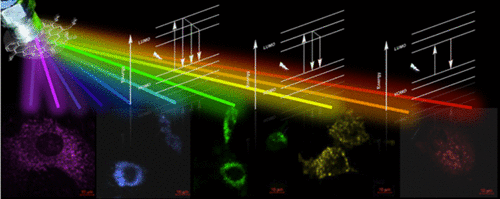当前位置:
X-MOL 学术
›
J. Phys. Chem. C
›
论文详情
Our official English website, www.x-mol.net, welcomes your feedback! (Note: you will need to create a separate account there.)
Exploring the Emission Pathways in Nitrogen-Doped Graphene Quantum Dots for Bioimaging
The Journal of Physical Chemistry C ( IF 3.7 ) Pub Date : 2021-09-21 , DOI: 10.1021/acs.jpcc.1c06029 I. Jénnifer Gómez 1 , Manuel Vázquez Sulleiro 2 , Anna Dolečková 3 , Naděžda Pizúrová 4 , Jiřina Medalová 3 , Rajarshi Roy 5 , David Nečas 6 , Lenka Zajíčková 1, 6
The Journal of Physical Chemistry C ( IF 3.7 ) Pub Date : 2021-09-21 , DOI: 10.1021/acs.jpcc.1c06029 I. Jénnifer Gómez 1 , Manuel Vázquez Sulleiro 2 , Anna Dolečková 3 , Naděžda Pizúrová 4 , Jiřina Medalová 3 , Rajarshi Roy 5 , David Nečas 6 , Lenka Zajíčková 1, 6
Affiliation

|
Graphene quantum dots (GQDs) with tunable fluorescence emission promise excellent bioapplication potential, especially in bioimaging. We report the synthesis of nitrogen-doped GQDs (N-GQDs) from glucose and ethylenediamine, cheap and safe chemicals, using a one-step and fast microwave-assisted hydrothermal method. Our N-GQDs exhibit fluorescence in the entire visible spectral region, which extends to near-ultraviolet and slightly to near-infrared. Since the origin of fluorescence and its relation to the structure and synthesis conditions are not yet fully understood, we also concentrated on the fluorescence mechanism explanation. Structural characterization with steady-state and time-resolved photoluminescence measurements indicated that band-to-band transitions, size effect, and different nitrogen and oxygen functional groups play a role in this multicolor emission. Remarkably, we found for the first time the evidence that directly relates a change in the N-GQD work function to the change in oxygen groups under UV irradiation via ultraviolet photoelectron spectroscopy. Thus, we confirmed that for λex ≲ 380 nm, photooxidation processes occurred, which led to chemical modification, thereby lowering the work function in the N-GQDs. The N-GQDs were proved to be highly biocompatible by a cell viability assay using vascular smooth muscle cells. Together with the wide spectral range emission observed in confocal fluorescence imaging, it demonstrated the potential of the N-GQDs for in vitro bioimaging applications.
中文翻译:

探索用于生物成像的氮掺杂石墨烯量子点的发射途径
具有可调荧光发射的石墨烯量子点 (GQD) 具有出色的生物应用潜力,尤其是在生物成像方面。我们报告了使用一步快速微波辅助水热法从葡萄糖和乙二胺、廉价且安全的化学品合成氮掺杂 GQDs (N-GQDs)。我们的 N-GQD 在整个可见光谱区都表现出荧光,延伸到近紫外和轻微到近红外。由于荧光的起源及其与结构和合成条件的关系尚未完全了解,我们也集中在荧光机理解释上。稳态和时间分辨光致发光测量的结构表征表明,带间跃迁、尺寸效应、不同的氮和氧官能团在这种多色发射中起作用。值得注意的是,我们首次通过紫外光电子能谱发现了 N-GQD 功函数的变化与紫外光照射下氧基团变化直接相关的证据。因此,我们确认对于 λex ≲ 380 nm,发生光氧化过程,导致化学改性,从而降低 N-GQD 的功函数。通过使用血管平滑肌细胞的细胞活力测定证明 N-GQD 具有高度的生物相容性。连同在共聚焦荧光成像中观察到的宽光谱范围发射,它证明了 N-GQD 在体外生物成像应用中的潜力。
更新日期:2021-09-30
中文翻译:

探索用于生物成像的氮掺杂石墨烯量子点的发射途径
具有可调荧光发射的石墨烯量子点 (GQD) 具有出色的生物应用潜力,尤其是在生物成像方面。我们报告了使用一步快速微波辅助水热法从葡萄糖和乙二胺、廉价且安全的化学品合成氮掺杂 GQDs (N-GQDs)。我们的 N-GQD 在整个可见光谱区都表现出荧光,延伸到近紫外和轻微到近红外。由于荧光的起源及其与结构和合成条件的关系尚未完全了解,我们也集中在荧光机理解释上。稳态和时间分辨光致发光测量的结构表征表明,带间跃迁、尺寸效应、不同的氮和氧官能团在这种多色发射中起作用。值得注意的是,我们首次通过紫外光电子能谱发现了 N-GQD 功函数的变化与紫外光照射下氧基团变化直接相关的证据。因此,我们确认对于 λex ≲ 380 nm,发生光氧化过程,导致化学改性,从而降低 N-GQD 的功函数。通过使用血管平滑肌细胞的细胞活力测定证明 N-GQD 具有高度的生物相容性。连同在共聚焦荧光成像中观察到的宽光谱范围发射,它证明了 N-GQD 在体外生物成像应用中的潜力。


























 京公网安备 11010802027423号
京公网安备 11010802027423号